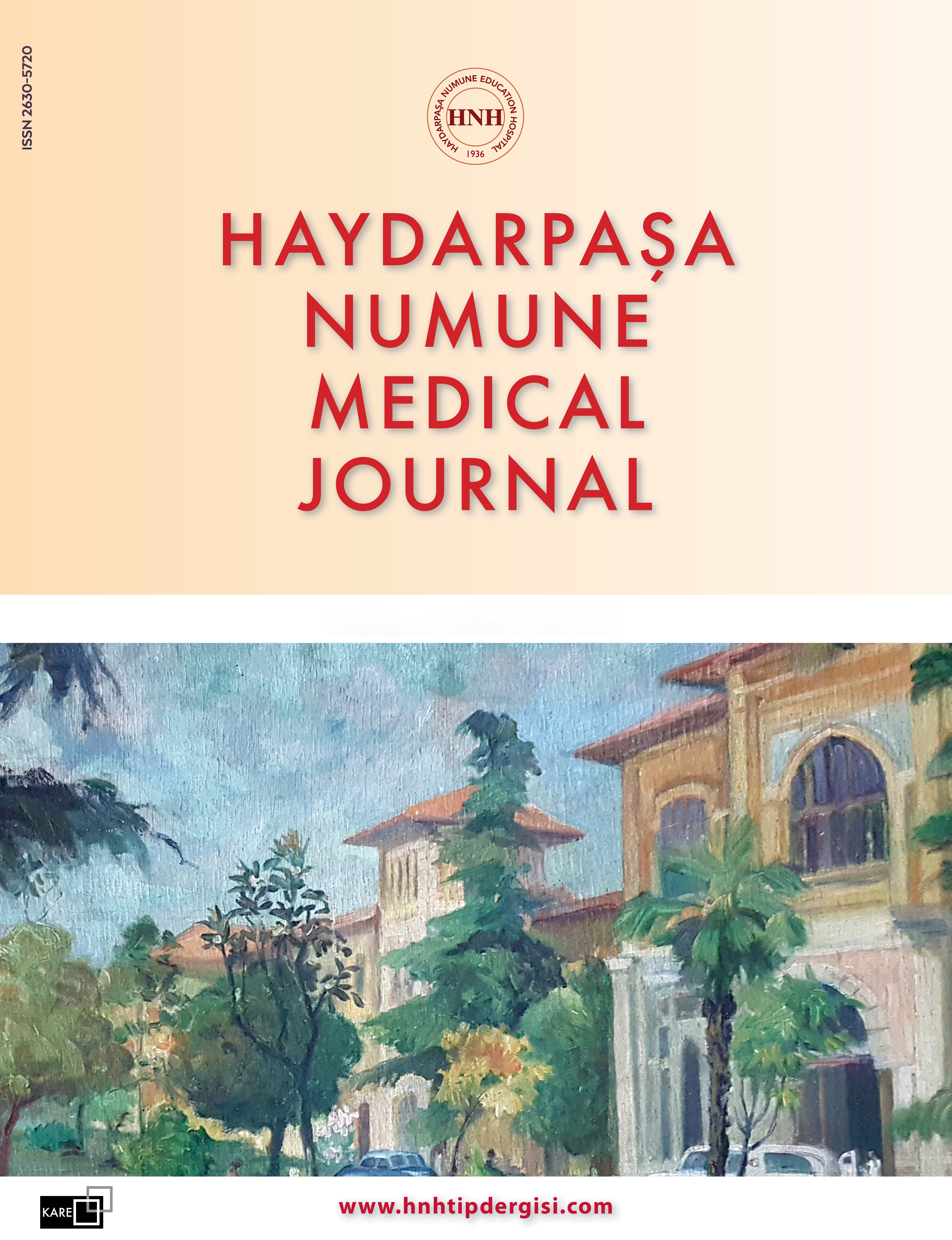Volume: 55 Issue: 1 - 2015
| RESEARCH ARTICLE | |
| 1. | Evaluation of the Pharmacists Who Work at the Government Hospital about Their Service Training Aygül Yanık, Nihal Çöl, Aslı Eki&775;n, Fikriye Toker Pages 1 - 10 INTRODUCTION: The purpose of this study to see that the evaluations, problems and solvings about in-service training of the government employee pharmasists. METHODS: It is used interview method at this study. The research universe contains 130 pharmasists who work at the government in Istanbul. The sampling selected as random and 98 full answered Questionnaire are included to the study. The research is descriptive and the data is analyzed with SPSS 15.0. RESULTS: It is established that the government employee pharmasists find not enough that their pharmacy education and actual job trainings. The high percentage of them said that in the service trainings about new medicine and usage, disease and threatment methods, new technological developments, professional regulations, communicaton and ethic must be organized as theoric and practic. It is seemed that in the present service training are not suitable to their needs. Organizations are not effective, and the time is not enough. The most important problems of the goverment employee pharmacist are the count of personnal and defective storage place. They said that the health ministerium, the pharmacy faculties and Turkish Pharmacist Assocaiton must be coordinated and organized actual Professional service-trainings.. DISCUSSION AND CONCLUSION: It is supposed that this study will support to the senior managements for the administrative decisions about in-service training plannings and organizations. |
| 2. | The Demographic CharacterIstics and The Satisfaction Rates of PatIents HospItalIzed In a PublIc RehabIlItatIon HospItal Başak Bilir Kaya, Duygu Kurtuluş, Gül Babacan Abanonu Pages 11 - 16 INTRODUCTION: This study is conducted cross-sectionally to determine the demographic characteristics and to measure the satisfaction rates of patients hospitalized in a public rehabilitation hospital. METHODS: The sample space of the study consists of 1017 patients admitted for inpatient rehabilitation between 01/01/2012 and 31/12/2012. Out of the 1017 patients, those who are at least 18 years old, conscious, able to communicate, without a psychiatric disease and willing to participate the survey were randomly sampled to form the study sample consisting of 15 patients/ month, totaling 180 patients/year. The study sample were asked to fill out the Ministry of Health Quality Management System Inpatient Services Satisfaction Survey Form. Based on patient responses, monthly, semi annual (first and second six months), and annual satisfaction rates were calculated. Out of the 1017 patients, 557 were male (55.1%), 454 were female (44.9%). The social security status of the patients were as follows: 997 SGK (universal health insurance), 12 of them have foreign nationality, 2 of them traffic insurance policies, 5: international insurance, 1: paid. From outside İstanbul, a total of 218 patients from 59 different cities were admitted. Annual bed occupancy rate was 99.3%. The distribution of patients according to diagnosis was as follows: 669 (65.8%) hemiplegia, 174 (17.2%) paraplegia, 123 (12%) orthopedic rehabilitation 51 (5%) rehabilitation of neuromuscular diseases. RESULTS: Among the patients who participated the survey, the highest satisfaction rates were regarding room cleanliness (99.6% - 100%), while the lowest satisfaction was expressed regarding the tastiness of the food (84.8% - 88.0%). The item showing most discrepancy between the first and second half of the year was the noisiness of the patient room and the environment (87.4%- 95.2%). Multidimensional measurement of hospital service quality at various times and evaluation of the changes in the results are important to increase the quality of service. DISCUSSION AND CONCLUSION: Therefore, patient satisfaction rates have to be measured and evaluated periodically. |
| 3. | The Relation Between Chronic Obstructive Pulmonary Disease (COPD) and Pneumothorax (A complication of Trans Thoracic Fine Needle Aspiration) Çiğdem Başkara, Murat Kıyık, Hüseyin Cem Tigin, Ayşin Durmaz, Tülay Sönmez, Sadettin Çıkrıkçıoğlu Pages 17 - 21 INTRODUCTION: Transthoracic fine needle aspiration (TFNA) is a method oftenly used to diagnose peripheral lung lesions. METHODS: The most frequent complication of TFNA is pneumothorax as 5-64%. We aimed in our study to demonstrate the relation between chronic obstructive pulmonary disease (COPD) and pneumothorax due to TFNA. RESULTS: We evaluated 367 times TFNA of 281 patients retrospectively and performed pulmonary function tests to appropriate patients and searched COPD. We detected pneumothorax as 13.1%. DISCUSSION AND CONCLUSION: We didnt detect a significant relation between COPD and TFNA (p>0.05). |
| 4. | Correspondence of Priority between DMSA Scintigraphy and Voiding Cystourethrography in Children with Urinary Tract Infections Selçuk Gürel, Zehra Esra Önal, Narin Akıcı, Çağatay Nuhoğlu Pages 22 - 30 INTRODUCTION: Vesicoureteral reflux (VUR), presents with the retrograde flow of urine from bladder to ureters, due to the immaturation of ureterovesical junction. METHODS: The importance of VUR in childhood is that, the history of urinary infections can cause end-stage renal disease by damaging renal paranchime. This study was performed to detect the value of dimercaptosuccinicacid (DMSA) scaning and renal ultrasonography (US) as alternative studies for children with urinary infections, to avoid voiding cystourethrography (VCUG) which is traumatic and hardly performed. We performed a retrospective study of 100 children, of 23 male, 72 female; between 1-15 years old aged, were hospitalized in our clinic with the diagnosis of urinary infections. When clean catch mid-stream urines were received from the children older than 5 years age, urinary catheterizations were performed for the Youngers of urine cultures. Urine culture, urinary US, VCUG and DMSA scanning were performed. The presence of VUR in VCUG was significantly higher in the group that had scars in DMSA scanning, than the group without scars. Seventeen patients having scars in DMSA scanning showed VUR in VCUG. We analyzed that, VUR of grade I and II can be detected in VCUG, unless they showed no focal scars in DMSA scanning. RESULTS: We performed a retrospective study of 100 children, of 23 male, 72 female; between 1-15 years old aged, were hospitalized in our clinic with the diagnosis of urinary infections. When clean catch mid-stream urines were received from the children older than 5 years age, urinary catheterizations were performed for the Youngers of urine cultures. DISCUSSION AND CONCLUSION: Urine culture, urinary US, VCUG and DMSA scanning were performed. |
| 5. | Comparation of Open and Percutaneous Release Methods in Treatment of Trigger Digits Ender Alagöz, Ozan Beytemur, Kahraman Demiryontar, Sever Çağlar, Mehmet Akif Güleç Pages 31 - 36 INTRODUCTION: Patients who do not benefit from steroid injection, and undergoing open or percutaneous A1 pulley release were evaluated retrospectively fort the frequency of complications, recurrence rates, and achievement levels. METHODS: 48 fingers of 45 patients whom open A1 pulley release were performed, and 35 fingers of 34 patients whom percutaneus A1 pulley release were performed were included the study. 54 patient were female, and 25 were male. Steroid injection performed the patients whom findings were persisted longer than 3 months. After 3 month follow-ups of injection if symptoms were ongoing A1 pulley release were planned. According to patient preference open or percutaneous release were performed. All operations were done with local anesthesia. Patients were controlled for local infection, pain, swelling, digital nerve or flexor tendon damage, inadequate release, and recurrence after operation. RESULTS: There was no evidence of local infection, digital nerve damage or flexor tendon damage in both groups. Recurrence was observed in one patient in both groups. Inadequate release was observed in 3 patients in percutaneous release group. The success rate was 97.8% in open release group, and 88.2% in percutaneous release group. Pain and swelling observed at 14th day visit was significantly more in open release group. DISCUSSION AND CONCLUSION: As a result when performed by determining the anatomical landmarks correctly, satisfactory results that are comperable with open A1 pulley release can be achived by percutaneous technique. Patients may be exposed to less local complications in early period and return to work earlier by the percutaneous technique. |
| 6. | Comparison of the Effects of Low-flow and High-Flow Anesthesia on Hemodynamics, liver and Renal Function Tests Güşen Bosna, Osman Ekinci, Arif Yılmaz, Bekir Kaplan, Sıdıka Batan Erdem, Asu Özgültekin Pages 37 - 44 INTRODUCTION: The use of lowflow anesthesia which has the advantages of economic, ecological and prevention of post-operative hypothermia is increasing in recent years. In our study, we aimed to compare the effects of low-flow anesthesia on hemodynamics, liver and renal function tests in patients undergoing thyroidectomy. METHODS: Total of 80 patients with ASA I-III, aged between 18-65 years undergoing thyroidectomy operations were included after getting informed consent. After induction of general anesthesia and endotracheal intubation, in both groups 4L/ min flow (50% O2, 50% N2O) was started, nesthesia was maintained with 4-6% volume desflurane. After 10 min, flow was changed to 1L/min in Group D. 10 min before the end of surgery, desflurane and nitrous oxide was stopped and gas flow of 4L/min changed to 100%O2. Hemodynamic measurements and SO2 were recorded every 5 minutes after intubation starting before anesthesia. Inspired and expired O2, CO2, desflurane values were noted. Samples for analysis of arterial blood gas, liver and renal function tests were taken and recorded before surgery and at postoperative 2 and 24 hours. Recovery period and side effects were evaluated. RESULTS: There was significant difference between mean arterial pressure measurements at 20, 25, 90 and 120 minutes after intubation (p<0.05). Perioperative SaO2, arterial blood gas analysis, liver and renal function tests were not different between two groups (p>0.05). DISCUSSION AND CONCLUSION: We concluded that low-flow anesthesia is as safe as high-flow anesthesia regarding hemodynamics, liver and renal function tests under anesthesia conditions with adequate facilities. |
| 7. | The importance of angle of fracture and the effects of results of the fixation methods in the treatment of isolated fractures of medial malleols Hakan Serhat Yanık, Atilla Polat, Mehmet Kerem Canbora, Şevki Erdem Pages 45 - 49 INTRODUCTION: Whether there is any effect of the angle of fracture to determine the type of operation method and the results of this type of surgery. METHODS: Patients(30) admitted to hospital which have isolated medial malleol fractures (IMMF) in between 2002 and 2006.Files of patients were reviewed for retrospective application (age,sex, fracture line from X-ray, fixation methods, postoperative X-ray). Statistically analysis questionnaire results. RESULTS: Fractures of IMMF had oblique of seven, transverse of nineteen, vertical of four.In 3 patients had type 3A open fracture. We applied screw to 17 patients which are 5 oblique, 9 transverse, 3 vertical.Mean follow time 49,7 month, AOFAS score mean 97,3 point..We applied osteosythese with zuggurtung to 13 fractures which were 2 oblique, 10 transverse and 1 vertical fracture. Mean follow time 37,8 month, AOFAS score mean 98,1.There was not effect of the angle of fracture to the determine the type of fixation(p=0,223).There was not effect of fixation to posttraumatic arthritis (p=0,550) and ankle function (p=0,867).There were no nonunion. DISCUSSION AND CONCLUSION: We evaluated that there is no effect of the angle of fracture to the determine the type of fixation and there is no effect of the type of fixation to results. |
| 8. | Comparison of hyperbaric bupivacaine and hyperbaric levobupivacaine undergoing perianal surgery under saddle spinal anesthesia Ömer Faruk Boran, Gülşen Bosna, Güldem Turan, Cem Coşar, Sıddıka Batan, Osman Eki&775;nci&775; Pages 50 - 57 INTRODUCTION: The aim of this study was to compare the saddle spinal block durations and hemodynamic effects associated with intrathecal hyperbaric bupivacaine and hyperbaric levobupivacaine in patient undergoing perianal surgery. METHODS: After approval by the hospital ethics committe and obtaining written informed consent; 60 patients, aged 18- 50 years, ASA I-II who were scheduled for elective perianal surgery were included. Patients were randomly divided into two equel groups receivingeither (in group B) 7.5 mg hyperbaricbupivacaine 0.5% or (in group L) 7.5 mg hyperbariclevobupivacaine 0.5%. After the saddle spinalanesthesia; the level and duration of sensoryblock, degree and duration of motor block were recorded. Heart rate (HR), mean arterialpressure (MAP) were recorded through out the study; at baseline and 2.5th, 5th, 7.5th, 10th,12.5th,15thmin after intrathecal injection, then at 5min intervals. A 20% or more decrease in MAP compared to baseline was considered as hypotension, iv ephedrine 5 mgr bolus administreted. Atropine 0.5 mg iv administreted when HR<50 beats/min. RESULTS: Demographic data were similar in both groups. Nosignificant difference between groups with MAP and HR. 3 patients (2 in group L, 1 in group B) were needed ephedrine. In group L, duration of the sensory and motor block were shortherth angroup B. DISCUSSION AND CONCLUSION: Hyperbaricbupivacaine and hyperbariclevobupivacaine both provided satisfactory saddle spinal anaesthesia with good haemodynamic stability for perianal surgery. |
| CASE REPORT | |
| 9. | Intravenous Lipid use in Mirtazapine Intoxication Bülent Serhan Yurtlu, Volkan Hancı, Mehmet Akın, Isıl Özkoçak Turan Pages 58 - 60 Drug intake from antidepressant and antiphychotic groups are observed frequently within the patients brought to emergency departments in intoxication clinic. In those patients who are treated for intoxication, main therapy is supportive in most of the cases if there isnt any special antidote for the drug or chemical. In this manuscript, intravenous lipid therapy is presented in patient whose general condition was worsened in spite of supportive therapy after intake of antidepressant, mirtazapine. |
| 10. | Intrauterine Device in the sigmoid colon: Case Report Gültekin Köse, Nurettin Aka, Cemile Kanlıkama, Murat Alpay Pages 61 - 64 Intrauterine device (IUD) is a common contraceptive method used worlwide, especially in the developing countries. Uterine perforation while inserting the IUD is a rare but important complication. The patient presenting to our clinic with pelvic pain reported having an IUD inserted 1,5 years ago. The intrauterine device could not be visualised by ultrasound, while a pelvic roentgenogram revealed an IUD in the pelvic area. Following preoperative preparations laparoscopy was done. The IUD was embedded in the sigmoid colon and only the removal strings could be seen. Surgical consultaion was requested during the operation. The 1 cm perforation which occured while removing the IUD from the colon was repared with primary sutures with a mini laparotomy. The patient was discharged without any complications. IUD localisation needs to be determined when the removal strings cannot be visualised during pelvic examination. Uterine perforation should be concidered in patiens when the IUD cannot be visualised in the uterine cavity. |
| 11. | Elbow Dislocation with Proximal Radius Fracture Güray Altun, Avni İlhan Bayhan, Atilla Polat, Levent Adıyeke Pages 65 - 68 Fracture of the proximal ulna with radial head fracture-dislocation is called Monteggia fracture. Bado classified these fractures according to dislocation of the radial head anteriorly, posteriorly or laterally. 67-yearold female patient with indoor accident was admitted to our emergency department. In radiographs, posterior elbow dislocation with proksimal radial shaft fracture was identified. Closed reduction of the elbow was performed and radius fracture was fixed surgically. Three weeks after the cast was removed and active exercises were started. We report the rare combination of a closed fracture of the upper third of the radius with ipsilateral posterior dislocation of the elbow joint and also propose an addition of a new fifth subtype to classification of Bado because of insufficiency about these fracture taxonomy. |
| 12. | Acute generalized exanthematous pustulosis (AGEP) due to the use of Phenitoin: Case Report Hülya Anıl, Eylem Kıral, Koray Harmancı, Işıl Bulur, Abdülkadir Koçak Pages 69 - 73 Acute generalized exanthematous pustulosis (AGEP) is a severe and rare eruption that develops mostly from factors related to drugs. It is characterized by a fever and a pustular eruption on the erythematous skin with an acute onset and without follicular localization. Etiopathogenesis has not yet been fully explained. In this article, we present a case of AGEP associated with phenytoin that developed in a patient followed up in the intensive care unit for uncontrolled seizures. Two years ago, maculopapüler rash occured after receving phenytoin at another service in our hospital so ın this presentation; we aimed to emphasize that AGEP can rarely be seen in childhood age and to review the clinical properties, diagnosis, treatment of disease. Also we aimed to emphasize the importance of anamnestic reports. |
















